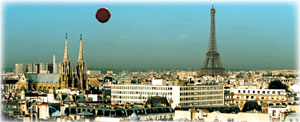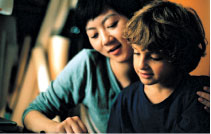Taiwanese director Hou Hsiao-hsien returned to the Riviera with his new film The Flight of the Red Balloon, which opens the Un Certain Regard section of this year's 60th Cannes Film Festival. The Taiwanese director, famed for his long, continuous shots and improvised dialogue, has been a frequent visitor to Cannes with no less than six films entered in the competition, and was awarded the Jury Prize in 1993 for The Puppetmaster. This year, Hou brings to the festival a very nostalgic look at Paris, a remake of 34-minute children's classic Le Ballon Rouge by French director Albert Lamorisse, which has won the Palme d'Or for best short film in Cannes more than half a century ago.
The renovated version is Hou's French-language debut starring French actress, Juliette Binoche, and Taiwan actress, Hsu Chi, and actor, Chang Chen. The movie follows the life of single parent Suzanne (Binoche), who struggles with the complications of modern life, raising her seven-year-old son Simon and expressing herself as a puppeteer. Suzanne hires a Taiwanese nanny, young filmmaker Song Fang, to look after Simon and the two bond over a short film she is making, which shows the young boy being followed by a mysterious red balloon. The balloon is an idly floating observer, silently witnessing the story among the three people rather than a simple direct participant.
"When I saw the original version, I thought there must be some other stories to develop between the boy and the red balloon," he said. "The balloon is free in the sky but the boy is not. He has a babysitter picking him up everyday and has lots of toys. But he is not as free as the balloon."
|

Taiwanese director Hou Hsiao-hsien set his new film The Flight of the Red Balloon in Paris.
|
Hou said that is why he set the story from 1950 till now. "The balloon is like a free soul waiting for someone to call it."
The 51-year-old director is one of the most acclaimed of the past two decades by film buffs and critics alike. Hou's films are difficult to understand, and no one is going to suggest that his films will make it big at the box office, but mass appeal should not be a determinant of aesthetic judgment.
"Personal style is not opposite to the market. What you shoot is life and the society. Your own experience also reflects and expresses others' experience. Why you say, 'I can't understand' is just because the habit of movie-watching is being changed," Hou said.
Hou's films have always displayed some element of the master-shot style, in which he tends to keep the audience emotionally distanced from the characters and the action. As a result, Hou's films are criticized as boring. But at his best, Hou can provoke overwhelmingly intense emotions precisely because the viewer has worked to get it.
Hou's films offer a generous store of images and feelings that generously reward time and patience. In the film, The Flight of the Red Balloon, Hou's camera casually follows Song and Simon as they wander about Paris, strolling through parks, stopping at a local bakery or visiting the Chinese puppet theater where Suzanne works as a voice actress.
"Making film, for me, is a process of re-discovering myself, in which I shoot from my experience to the outside world," he said.
Hou believes that there are two kinds of relationship between the viewers and directors.
One is facing the viewers, which means the director has to keep guessing what the viewers think. The other one is just showing the back to the viewers, which means the director does not have to shoot film like a server. "The later one is the real creation, where the director shows his/her thoughts and shares with the viewers," he said.
The Flight of the Red Balloon is a departure for Hou, who has placed all but one of his films on the island of Taiwan.
It is the first film in a series initiated by the president of Paris' Muse d'Orsay, Serge Lemoine, in conjunction with the museum's 20th anniversary. The idea is to bring together contemporary artists, in this case, world-class filmmakers, and the Museum's Impressionist or Art Nouveau treasures. The terms are particularly simple: the museum must be present, either throughout the film or just a scene. This is how Hou came to scout locations for the first time in Paris, starting for the adventure of this film.
|

French child Simon and his Taiwannese nanny Song Fang.
|
Hou admitted to feeling nervous about portraying the city of love and getting under the skin of the Parisians. The director said he had been encouraged by the experience of shooting his 2003 film Cafe Lumiere in Tokyo, Japan and said he felt ready to make a movie outside Asia.
"I've made films for over 30 years and I never dared to shoot in a different country," said Hou. "I believe that a film is like an essence of that country, the people, their everyday life, the culture, but all those details are difficult to be truthfully presented on the screen and seen from a foreigner's point of view."
Hou said making a foreign language film is just a challenge, not a plan for the Hollywood market. He believes movies are divided into two groups: good and bad. A good movie, he said, should be simple and touching, and in the meantime, powerful. "It's most difficult to make a powerful movie because truth is usually beyond words and images," he said.
"I want to explore the stories under different cultural situations, not only in France, but in different cities within China."
Hou said his next target city may be Beijing, which he thinks of "as mysterious" and "hard to catch the pace of people who live there".
(China Daily 05/23/2007 page6)